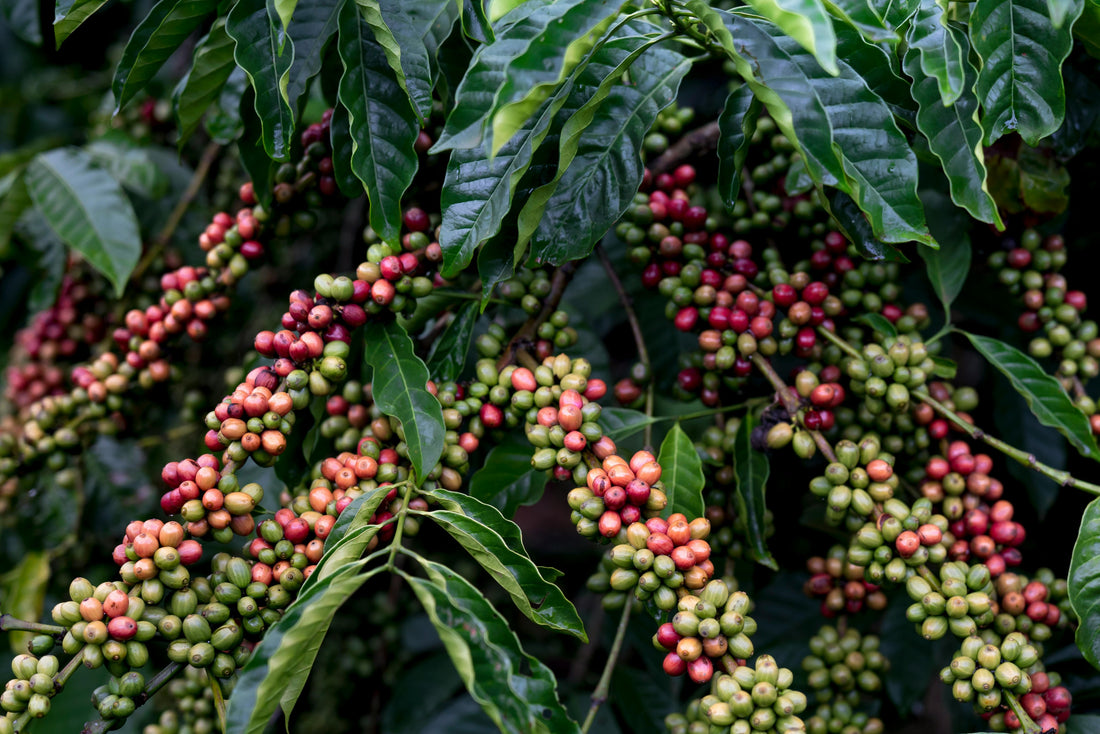
What is Arabica Coffee? Everything You Need to Know
Share
Arabica coffee, renowned for its rich and complex flavors, is the most popular coffee species in the world. Appreciated by connoisseurs and grown in the best regions, it offers a unique experience in the cup. Discover everything you need to know about Arabica, from its origins to its preparation methods.
1. What is Arabica coffee?
Arabica coffee, also known by its scientific name Coffea arabica , is the most prized and widely cultivated species in the world. Known for its subtle aromas and complex flavors, this species accounts for approximately 60% of the world's coffee production. Arabica coffee beans are often preferred for their sweetness and low acidity, making them an ideal choice for premium coffee lovers. Grown primarily in mountainous regions, Arabica coffee beans require specific conditions to reveal their full aromatic potential. Whether you are a coffee enthusiast or a professional in the industry, understanding the specificities of Arabica will allow you to fully appreciate this exceptional beverage.
2. History and Origins of Arabica Coffee
The beginnings of Arabica coffee
The origins of Arabica coffee date back centuries to Ethiopia, where it was first discovered. According to legend, a shepherd named Kaldi noticed that his goats were particularly energetic after eating cherries from a certain shrub. Intrigued, he tasted the cherries himself and felt a similar liveliness. This discovery led to the use of coffee beans for their stimulating properties.
Worldwide spread and popularity
After its origin in Ethiopia, Arabica traveled across the Red Sea to the Arabian Peninsula, where it was cultivated and traded. The city of Mocha in Yemen became a major center of the coffee trade in the 15th century, giving its name to the famous mocha coffee. Arab traders then introduced coffee beans to the rest of the world, particularly to Europe, where they quickly gained popularity.
Arabica coffee continued to spread through exploration and trade, reaching the Americas and Southeast Asia. Today, countries such as Brazil, Colombia, and Ethiopia remain among the major producers of this species, contributing to its global fame. The global spread of Arabica coffee has not only transformed local cultures, but also established coffee as a staple beverage in many societies.
3. Botanical Characteristics of Arabica
Description of the plant
Arabica coffee (Coffea arabica) is a shrubby plant that can grow up to 4.5 metres tall in the wild, although in commercial plantations it is often pruned to around 2 metres to facilitate harvesting. The leaves of the Arabica plant are usually oval in shape and dark green in colour, with slightly wavy edges. The flowers of the plant are small, white and very fragrant, similar to jasmine flowers. After flowering, the coffee cherries, which contain the coffee beans, take around 7–9 months to mature.
Ideal growing conditions
Arabica coffee beans require specific conditions to grow and produce high-quality beans. They prefer high altitudes, typically between 600 and 2000 meters above sea level. The mountainous regions of the tropics offer ideal temperatures of 15 to 24 degrees Celsius.
The soil should be well drained, rich in organic matter, and slightly acidic with a pH of 6 to 6.5. Arabica is sensitive to extreme climatic variations and diseases, particularly coffee rust (Hemileia vastatrix). Regular and well distributed rainfall, between 1200 and 2200 mm per year, is crucial for optimal growth.
These specific conditions contribute to the complexity and finesse of the aromas of Arabica coffee, making each harvest a unique product reflecting the terroir where it is grown.
4. Flavors and Aromas of Arabica
Typical flavor profile
Arabica is known for its complex and refined flavor profile. Unlike other species, Arabica offers a smoother, more nuanced flavor palette with low acidity. Typical aromas include floral, fruity, berry, stone fruit, and sometimes even hints of honey and chocolate. This diversity of flavors makes Arabica coffee beans a favorite choice for connoisseurs and baristas looking to create unique taste experiences.
Comparison with other species
Compared to Robusta (Coffea canephora), Arabica is milder and less bitter. Robusta has a stronger, earthier, and harsher taste, with a higher caffeine content, which may make it less enjoyable for some coffee lovers. Robusta is often used in blends to add body and crema, especially in Italian espressos. However, for those looking for a subtle and complex tasting experience, Arabica coffee remains unmatched.
The distinctive nuances of Arabica coffee are also influenced by terroir – the climate, soil, and farming practices of each growing region. This variability allows coffee lovers to experience an impressive range of flavors and aromas, with each region bringing its own unique twist to the taste profile.
5. Arabica Coffee Producing Regions
Main growing regions
Arabica is grown primarily in tropical regions of the world, where climatic and geographical conditions are ideal for its growth. The main producing regions include:
- Central and South America : Brazil is the largest producer of Arabica coffee in the world, followed by Colombia and Honduras. These countries offer perfect climatic conditions and high altitude, producing coffees with rich and varied flavors. Costa Rica and Guatemala are also renowned for their high-quality Arabica coffees.
- East Africa : Ethiopia, the birthplace of Arabica, is famous for its coffees with unique flavor profiles, often floral and fruity. Kenya and Rwanda also produce high-quality Arabicas, known for their crisp acidity and complex notes.
- Asia and the Pacific : Indonesia, particularly the islands of Sumatra and Java, produces Arabica coffees with earthy and spicy flavors. Papua New Guinea and Yemen are also notable producers, offering distinct flavor profiles.
Specificities of the different terroirs
Each Arabica growing region has unique characteristics that influence the flavor profile of the beans. Key factors include:
- Altitude : Coffees grown at higher altitudes tend to develop more complex flavors and stronger acidity.
- Climate : Variations in temperature, precipitation and humidity affect the development of coffee cherries and, therefore, the taste of the beans.
- Soil : The composition of the soil, rich in minerals and organic matter, contributes to the nutrition of coffee plants and the quality of the beans.
- Agricultural practices : Cultivation and post-harvest processing methods, such as drying and fermentation, also play a crucial role in defining the flavor profile.
Understanding the specificities of different terroirs allows us to appreciate the diversity and richness of Arabica coffees from various regions of the world.
6. Methods of Cultivation and Harvesting of Arabica Coffee
Cultivation techniques
Growing Arabica coffee requires careful attention to environmental conditions and agricultural practices. Here are some of the commonly used techniques:
- High Altitude Planting : As mentioned earlier, Arabica coffee prefers high altitudes, which helps develop more complex flavors.
- Shade Growing : Often, Arabica plants are grown under the shade of larger trees, which helps protect the plants from intense sun and maintain a more stable temperature.
- Pruning Practices : To maintain plant health and facilitate harvest, coffee farmers regularly prune coffee plants to encourage new growth and improve yield.
- Using disease-resistant varieties : Growers select Arabica varieties that are more resistant to diseases such as coffee rust to ensure healthy harvests.
Sustainable and environmentally friendly practices
Sustainable Arabica coffee production is increasingly favored by environmentally conscious producers. Here are some of the common practices:
- Organic farming : Using organic farming methods, without pesticides or chemical fertilizers, helps preserve biodiversity and maintain soil health.
- Water Conservation : Water conservation techniques, such as rainwater harvesting and drip irrigation, are used to reduce water consumption.
- Composting and Natural Fertilization : Coffee growers often use compost and other organic amendments to fertilize coffee plants, improving soil structure and fertility.
- Selective harvesting : Hand-harvesting coffee cherries, selecting only those that are ripe, results in higher quality beans and reduced waste.
These growing and harvesting methods not only contribute to the production of high-quality Arabica coffees, but also to the preservation of local ecosystems and the support of farming communities.
7. Economic and Social Importance of Arabica Coffee
Economic impact
Arabica coffee plays a crucial role in the global economy, providing a vital source of income for millions of people. Major producing countries, such as Brazil, Colombia, and Ethiopia, rely heavily on coffee exports to support their local economies. In addition to generating foreign exchange, coffee production creates jobs in the growing, harvesting, processing, and distribution sectors.
Fluctuations in coffee prices on the international market can have significant repercussions on the economies of producing countries. Therefore, the stability and sustainability of coffee production are essential to ensure the economic security of farmers and workers in the sector.
Fair Trade Initiatives
Fair trade is an important initiative that aims to improve the living and working conditions of Arabica coffee farmers. By offering fairer prices and ensuring ethical business practices, fair trade allows coffee farmers to receive fair compensation for their work. This helps to reduce poverty and promote sustainable development in coffee-producing communities.
Fair trade initiatives also include support programs to improve cultivation techniques, build producer skills, and promote environmentally friendly farming practices. By purchasing Fair Trade Arabica coffee, consumers can contribute to positive and sustainable change in the coffee industry.
In addition, many coffee cooperatives support community projects, such as building schools, improving local infrastructure and providing health care. These social initiatives strengthen the well-being of communities and promote harmonious and equitable development.
10. Conclusion
Arabica coffee, with its deep origins and rich history, remains one of the most loved and sought-after coffee species in the world. From its beginnings in Ethiopia to its global spread, Arabica coffee has captivated coffee lovers with its complex aromas and delicate flavors.
By understanding the unique botanical characteristics of the plant, the ideal growing conditions, and the different cultivation and harvesting methods, one can better appreciate the diversity of flavor profiles offered by Arabica coffees. Each producing region, with its own terroir specificities, contributes to this taste richness.
The economic and social impact of Arabica coffee cannot be underestimated. Fair trade initiatives and sustainable practices not only enhance the quality of coffee, but also the well-being of farming communities. By choosing Arabica coffees from these initiatives, consumers can support ethical and environmentally friendly production.
To enjoy Arabica coffee in all its glory, it is essential to follow precise preparation tips and use the best brewing methods. Avoiding common mistakes and applying the suggested solutions ensures a tasty and satisfying cup of coffee every time.
Why choose Arabica coffee?
Arabica coffee offers an unparalleled sensory experience, with a richness of aromas and flavors that vary depending on its origin and preparation method. In addition to its exceptional taste, choosing Arabica coffee means supporting sustainable farming practices and producer communities around the world.
In short, Arabica coffee is not just a drink, but a journey through the cultures, landscapes, and histories of the producing regions. Whether you are a coffee lover or a seasoned connoisseur, Arabica coffee promises to offer you an unforgettable coffee experience.

